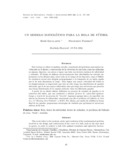Mostrar el registro sencillo del ítem
Un Modelo Matemático para la bola de Fútbol
Un Modelo Matemático para la bola de Fútbol
| dc.creator | Escalante, René | |
| dc.creator | Pacheco, Francisco | |
| dc.date.accessioned | 2015-05-19T18:43:00Z | |
| dc.date.available | 2015-05-19T18:43:00Z | |
| dc.date.issued | 2012-03-01 00:00:00 | |
| dc.identifier.citation | http://revistas.ucr.ac.cr/index.php/matematica/article/view/254 | |
| dc.identifier.issn | ||
| dc.identifier.uri | https://hdl.handle.net/10669/12900 | |
| dc.description.abstract | This work refers to the analysis, study and resolution of the mathematical problem involved in the design and construction of the cover of a ball, such as the ones used in sports, in order to achieve a ball with optimal roundness and sphericity factors.The design of well distributed ball structures has grown in importance in the last years, most of all in the field of sports, such as soccer. The current trend is directed mainly towards finding a fast ball that will give more dynamism to the game. In order to achieve a greater velocity of the ball during its movement it is important that it has not only an adequate distribution of panels, that give it a greater sphericity, but also that it has a structure that allows for a good distribution of the existing tension between the panels. Starting from an initial design, we define a process of readjustment of the panels in the ball cover, which will lead us to obtain optimal sphericity factors. Then, through a “twisting” process, we can add area to the surface without altering the sphericity factors, and solving the Missing Area Problem (or MAP). Finally, by redefining the final form of the panels, we propose tessellate strategies that will optimize the ball’s spherical structure. | |
| dc.description.abstract | Este trabajo se refiere al análisis, estudio y resolución del problema matemático involucrado en el diseño y construcción de la cobertura de una bola, como las utilizadas en algunos deportes, con miras a lograr una bola con factores óptimos de esfericidad y redondez. El diseño de balones estructuralmente bien distribuidos ha cobrado importancia en los últimos años, sobre todo en el campo de los deportes, como el fútbol. La tendencia actual está dirigida principalmente a la búsqueda de un balón rápido que le de más dinamismo al juego. Para lograr una mayor velocidad del balón en su desplazamiento es importante que éste no sólo tenga una distribución de paneles adecuada, que le de una mayor esfericidad, sino que tenga una estructura que permita una buena distribución de la tensión existente entre los diferentes paneles. A partir de un diseño inicial, definimos un proceso de reajuste de paneles en la cobertura del balón, que nos conducirá a obtener factores de esfericidad óptimos. Luego, a través de un proceso de “torsión”, logramos agregar área a la superficie sin alterar los factores de esfericidad, resolviendo con ello el problema del faltante de área (i.e., el “Missing Area Problem”, o MAP). Por último, por medio de redefinir la forma final de los paneles, proponemos estrategias de teselado que optimizan la estructura esférica de la bola. | |
| dc.format.extent | 97-109 | |
| dc.relation.ispartof | Revista de Matemática: Teoría y Aplicaciones Vol. 12 Núm. 1-2 2012 | |
| dc.title | Un Modelo Matemático para la bola de Fútbol | |
| dc.title | Un Modelo Matemático para la bola de Fútbol | |
| dc.type | artículo original | |
| dc.date.updated | 2015-05-19T18:43:00Z | |
| dc.language.rfc3066 | es | |
| dc.identifier.doi | 10.15517/rmta.v12i1-2.254 |


